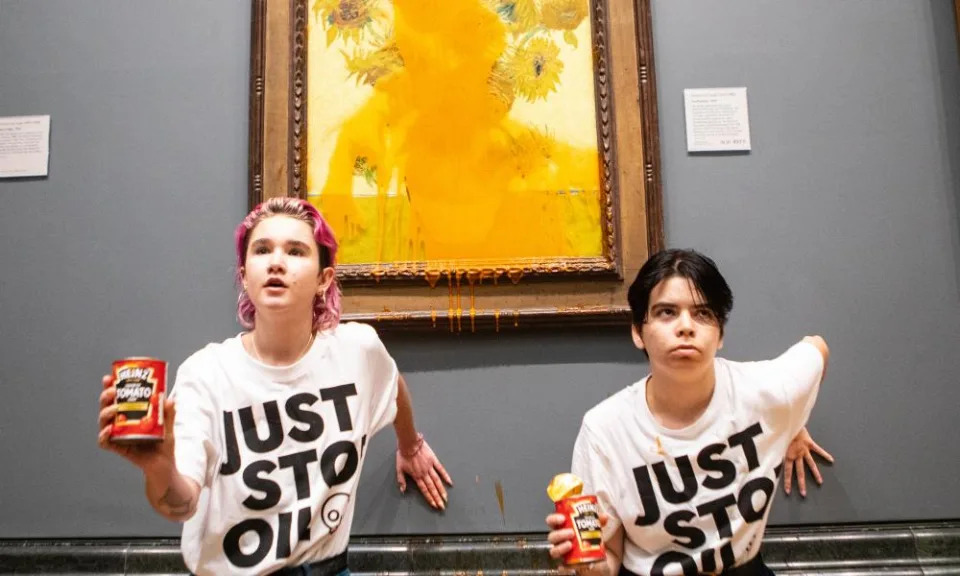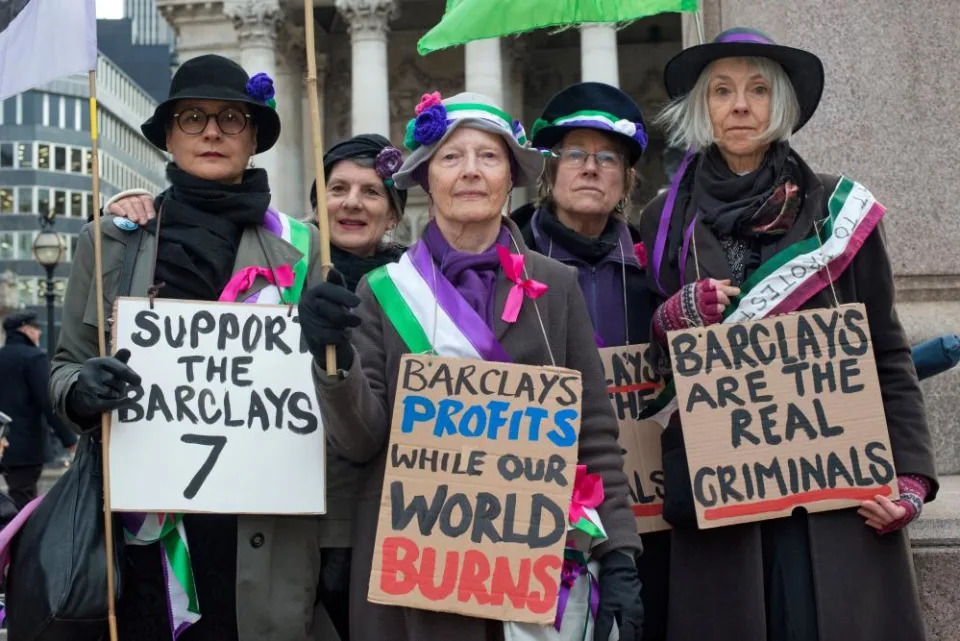‘They’ve taken away my freedom’: the truth about the UK state’s crackdown on protesters
Natasha Walter
Sun, 5 February 2023

Photograph: Antonio Olmos/The Guardian
Melissa is a down-to-earth, friendly woman in her 50s, and it seems that she has always met life with a certain amount of courage. She grew up on another continent, and after early motherhood, then divorce and a first career in business, she moved to the UK with her second husband. She then built another career working with survivors of domestic violence, before setting up a climate emergency centre in Abingdon, Oxfordshire.
The 100 days that she spent in prison last year do not seem to have been as shocking an interruption to her life as one might have expected. “You have to remember that I chose to do the actions that led to prison. Most women in prison are not in that situation at all.” Melissa was imprisoned after being arrested more than a dozen times on climate protests. Her first time behind bars occurred after she sat down in front of an oil terminal, in breach of an injunction banning protest in the area.
Yet even going to prison did not dampen her energy. “We continued the campaign in prison,” she tells me. “One day after exercise time we refused to go back into our cells. Instead we asked to see the governor and demanded education in the prison on the climate emergency.” The response, she says, was “cruel, it was painful”. She says she was restrained in a way that hurt so much that it made her want to vomit, then handcuffed, and placed in segregation. “‘Welcome to prison,’ the officer said.”
Related: UK climate activists held in jail for up to six months before trial
She found that many women in the prison were sympathetic. Other inmates beat on their cell walls in anger as they saw her being restrained. On her release, a band from the Just Stop Oil network came to play at the prison. “We stayed there for three hours, singing to the women still inside.” When she went to prison the second time, some inmates remembered her. “They said: ‘Oh, you are the one who brought that music.’ They were curious about what motivated me. We had a lot of productive conversations.”
I talked to Melissa because I want to understand why it is that more and more environmental protesters are ending up in prison in this country, and what this means for them – and for all of us. Last year, more than 100 protesters were imprisoned. This represents a massive change in the relationship between state and protesters. Raj Chada, a leading criminal lawyer at Hodge Jones & Allen (who has also given me legal advice), tells me: “I’ve been representing protesters for 15 years. I never had a client in prison before 2021. Now I have dozens. It is a completely new experience. It’s a completely new scenario that we are in.”
* * *
When I discuss this movement, I am not doing so as an outsider. I found the emergence of Extinction Rebellion in 2018 both intriguing and inspiring, and in 2019 I was arrested while blocking a road with others in order to enable demonstrations to take place in Trafalgar Square. I was arrested again last year during a protest outside a free market thinktank.
I was first drawn to support these protests because they presented such a visible opportunity to raise awareness and put pressure on government to deal with the climate emergency. And the energy on the streets was exhilarating. People were blocking roads and getting arrested in 2019, but what I will always remember is the music. A young woman singing lyrical protest songs through a loudhailer at rows of police in Trafalgar Square; the drums that always seemed to turn up when people were getting tired; a huge seated crowd singing in harmony outside the Treasury. Music flowed through the streets with the marchers, and under all the melodies something shifted for me, and not only for me.

Women dressed as suffragettes demonstrate outside Southwark Crown Court in support of the Barclays seven, January 2023. Photograph: Sophia Evans/The Observer
Ricky, a carer from west London, had been involved in the environmental movement for some time when Extinction Rebellion came along. “It felt fresh and new and creative,” he says. “So many people picked up on the urgency that we’d been talking about.” At first, the police seemed taken by surprise by the confidence of the protesters, which helped the movement to take up space in London and get off the ground. As Ricky says: “The dial moved.”
From 2016 to the end of 2019, polls show that climate change jumped from being seen as the 13th to the second most important issue facing the country. Those who were very worried about climate change doubled. Ricky also points to changes in rhetoric in the corridors of power. “You felt the shift everywhere. You saw local councils and parliament declaring a climate emergency.”
This shift wasn’t just down to Extinction Rebellion, which has always been part of a wider movement, and was never a perfect organisation. XR could be problematic in all sorts of ways, particularly in its startling inability to diversify its leadership or membership. But it bubbled with undeniable energy alongside other international groups including Fridays for Future, and other local protests, including against HS2. As more scientific evidence came in, more unprecedented weather events were experienced, and more broadcasters and writers explained what we were facing, more and more people were joining together to demand change. It felt like an unstoppable wave. And then what happened?
“It stopped,” Ricky says. “The pandemic hit. We went home. What we thought we’d achieved turned out to be greenwashing. Yes, parliament declared a climate emergency. But it took no action.”
More aggressive policing had already been seen as the protests really got under way, including an attempt on a blanket ban on demonstrations in London through a section 14 order in October 2019. Then, during the pandemic, police were given new powers to stop public gatherings. Those climate protests that did take place during 2020 and 2021 were more muted and tentative. The energy on the streets shifted to more diverse protests around racial justice and violence against women, which were often severely restricted by police. As Britain opened up again, environmental protesters found themselves in a much more confrontational situation with the police, the courts and the government.
Chada dates the beginning of a more punitive response to 2021, when he was representing James Brown, a Paralympian who had climbed on an aeroplane to protest the role of aviation in the climate emergency. Chada was shocked when Brown was not only found guilty of causing public nuisance, but also given a 12-month prison sentence. “That was a watershed moment,” he tells me. “Up until then there was very much a convention that peaceful protesters were not sent to prison. Even before new legislation was passed in 2022, that decision gave the green light that prison sentences were acceptable. We are seeing a new climate now in the courts.”
The move into greater confrontation between protesters and the state has also been driven by activists. “I love Extinction Rebellion,” says Ricky, “but sometimes, going through London banging the drums, you start to feel like a tourist attraction rather than a political movement.” It seemed incomprehensible to protesters eager for change that the government would not even take first steps to reduce our reliance on fossil fuels, such as investment in home insulation or ending new oil and gas licences.

In 1913 Emily Davison died after throwing herself, as a suffragette protest, beneath the King’s horse in the Derby. Photograph: PA
When Insulate Britain – formed in 2021 by six XR activists – first started to sit down in main roads and block traffic, they shone a light on this inaction. “At first I thought Insulate Britain was a bit crazy,” Ricky admits. “But then I saw how by being so disruptive they were moving debate on again, getting people talking. And then when I saw that Just Stop Oil were getting ready to block oil terminals, I decided to join them.”
Just Stop Oil has been protesting at oil terminals since April 2022: climbing on tankers, blocking gates, and even tunnelling under entrances. These are direct action protests, with the straightforward aim of stopping the use of fossil fuels. But those are not the protests that generate the greatest publicity. Our society is more likely to react to stunts with unexpected visual impact – soup splashing on Van Gogh’s Sunflowers; a young man locked by his neck on to a football goalpost; two men in hammocks suspended over a bridge.
I’ve heard a lot of discussion recently about what impact such tactics will have. History tells us that civil disobedience has played a vital role in one political movement after another. Workers’ rights, universal suffrage, race equality, anti-colonialism – all these causes have been taken forward by people seen as criminals by one generation and as heroes by the next. While current protests may be disruptive, they can also seem tame compared with methods embraced by other, now lauded, movements. Compare soup running off a glass screen with the suffragette who slashed a Velázquez painting with a knife; compare a few people sitting in the road with the suffragettes’ arson and bombing campaigns.
But we cannot look to history for any exact parallels with the current moment, or for any certainty about the future. So it’s unsurprising that the movement is split – not only between those embracing disruptive action and those who want to build a moderate flank, but also among many other positions. Yet, oddly, these splits do not usually seem to me to be bitter. There appears to be a growing understanding that different tactics need not be a zero sum game. Actions that disrupt everyday life can create jolts of energy, but even those who take part in them know they are not going to be enough on their own. Recent research has shown that disruptive action can increase support for organisations working for change using more conventional methods.
* * *
The state’s response, meanwhile, is simply to ignore, silence or punish protesters. The Police, Crime, Sentencing and Courts Act, passed in 2022, made the offences of public nuisance and obstruction of the highway more serious and more likely to result in prison sentences. One of the first to feel its effects was Jan Goodey, a university lecturer who climbed on a gantry on the M25 last November. He was convicted under the new statutory offence of public nuisance and given a six-month prison sentence. The magistrate said the imprisonment was intended as a “deterrent”. Goodey seems sanguine when I speak to him by email about his prison sentence: “It was an early shot across the bows in the government’s futile, shortsighted attempt to stymie resistance,” he writes.
The public order bill currently passing through parliament will enable police and the courts to push back ever harder on the right to protest, and threatens longstanding freedoms. Startling new measures have been proposed, including the criminalisation of tactics such as “locking on” and the extension of stop and search powers. If this bill becomes law, even people who have never been convicted of any offence could be banned from attending protests, tagged, monitored online, and stopped from associating with named others.
Already, as the government puts pressure on the police to stop dissent, it’s not only those who sit down in the roads who are feeling the change. Journalists have never been entirely immune from heavy-handed police response when reporting on protests, but last autumn there was an unprecedented wave of arrests of reporters at Just Stop Oil actions. One police chief seemed to imply that this was not an accident, saying that reporters were “part of the problem” and they should not give protesters “the oxygen of publicity”.

XR activists during a Just Stop Oil protest in London, April 2022. Photograph: Extinction Rebellion/Reuters
And more people who thought they were acting within the law are now finding themselves in a police cell. Jane, for instance, recently came to London to support a protest at a building with links to fossil fuels. She doesn’t want to be arrested, so she took a role known as the de-escalator. “You are there to take the heat out of the situation, making sure it doesn’t become adversarial,” she says, “so that everyone remains safe.” That day, Jane was wearing a de-escalator bib and kept her distance from the people who sprayed water-based paint on the building. “I talked with the security guards, who came out of the building and asked what we were doing. I explained that this was a nonviolent protest against the 100 new oil and gas licences. They were sweet and said that they were with us in spirit.” Jane then walked up and down talking to members of the public. “I look middle-aged, middle-England, tidy, people wouldn’t look at me and say, she’s an activist. We were there for about 45 minutes after the action.
This pushback reduces the number of people who can get active. Most of us can’t even think of being arrested, let alone going to prison
“Then three van-loads of police came up, jumped out, went to the arrestables first, and then picked me out from the other people standing around. They said that they were going to search me. In my bag was an unused smoke flare and stickers, and they said: that looks like intent to cause criminal damage. They decided they were going to arrest me. I was shocked. I was held for about 12 hours in the police station, and then given bail conditions not to enter Westminster or the City of London for 28 days. Twenty-eight days later, on my return to the police station, they held me again for eight hours, and gave me another two months with the same bail conditions. I am innocent. I haven’t been charged with anything. They’re taking away our right to protest. They’ve taken away my freedom.”
Many might observe that it was naive of environmental protesters not to have predicted more aggressive policing, and that other groups, particularly black people who have experienced far more injustice in the criminal justice system, could have told them long ago what to expect. This is true. But it’s also true that this new clampdown on protest is evidence of a wider authoritarian turn in government, which encompasses not only the desire to shut protesters up, but also to clamp down on the right to strike among workers, and to bolster the hostile environment against migrants.
A similar direction of travel can be glimpsed in other countries that have previously tolerated nonviolent protest. In Australia, controversial new laws were passed in 2022 that introduced draconian new sentences for blocking roads and bridges. The protester Deanna “Violet” Coco was handed a 15-month sentence for blocking traffic on Sydney’s Harbour Bridge. In Germany, activists resisting the development of a new coal mine in Lützerath have accused the police of “pure violence”. In the Hague last month, Extinction Rebellion activists planning a protest were detained under suspicion of “sedition”, and Greenpeace stated: “The right to protest is being increasingly restricted in the Netherlands.” In the US, a climate activist was killed in January at a protest camp protecting a forest from development. State authorities have said that a police officer shot in self-defence. His mother has stated: “I am convinced that he was assassinated in cold blood.”
In less open countries, environmental protesters have long faced far more aggressive treatment from the state. They have to find true courage simply to share information, let alone engage in civil disobedience. More than 1,700 environmental activists have been killed in the past decade, particularly in Latin America.
While we face nothing like that in the UK, it is hard to predict where the current criminalisation may take us. The clampdown we are seeing is already having a chilling effect. One man I spoke to, Oliver, a father from north London, says: “This pushback creates a climate in which XR and Just Stop Oil are characterised as criminal organisations. So people feel entitled to condemn us. They don’t even want to talk to us. But it also reduces the number of people who can get active, who are prepared to get out on the streets. Most people can’t even think of being arrested, let alone going to prison. This is killing one of the most engaging and impactful environmental movements of the past 100 years.”
As I speak to people in the climate movement, I pick up a measure of fear and despondency from many who, like Oliver, have currently put their own plans to join disruptive protest on hold. But from others I pick up a dogged determination that does not seem to be fading.
Melissa sounds far from despondent, after all, despite more than 100 days behind bars. When I ask what’s next for her, she tells me: “In terms of how I think, how I feel… it’s positive. I am still very much motivated to do whatever is needed. I will not be afraid.” And Jan Goodey, writing to me from prison, says: “I would have done the same if I’d known the sentence.”
Some protesters remind me that despite the clear messages being sent by government, juries and judges still often find protesters not guilty, or impose the lightest possible penalties. Those who want to shut down this wave of protest may find the task much harder than they expect. Most people now understand that urgent change is needed to avert environmental catastrophe. The fact that those in power are choosing not to take any meaningful action to prevent climate instability and ecological destruction, while arresting and locking up those who raise the alarm, may even galvanise supporters.
* * *
On a cold Friday at the end of January, seven women who had cracked windows at Barclays to protest their financing of fossil fuels were facing sentencing, with the prospect of up to 18 months in prison. As the Barclays seven, as they are known, walked to the court, they were accompanied by hundreds of people. Many of us were dressed as suffragettes, and with us were some unexpected allies. Alongside the climate activists who spoke outside the court were Helen Pankhurst, recalling the legacy of her suffragette ancestors and their courage in speaking truth to power; and Pragna Patel, a founding member of Southall Black Sisters, who connected the climate movement to other struggles for justice and freedom. “Our right to protest is under attack everywhere,” she said.
Over and over again, the protesters burst into song. There were no drums this time, but there were confident voices weaving in and above the traffic, rising into the cold London air. Flags fluttered, and placards were held high. “Nature defenders are not criminals,” the banners said, “Courage calls to courage.”
In the crowd I see Clare Farrell, one of the founders of Extinction Rebellion. She reminds me that the group is planning for huge protests this spring that she hopes will include not only the climate movement, but also nature organisations and campaigners for social justice. These are not being planned as disruptive protests, in tune with Extinction Rebellion’s recent pledge to “quit” disruption of the public. But all protest contains an element of disruption, even if it is only to the accepted political narratives that feed off inertia. “The hope,” she tells me, “is to shine a light on the systemic failure in our politics, not just on the climate and environment, but also on poverty and injustice.”
And is she hopeful, that people are ready to come out into the streets, and that they will be able to make the demand for change into reality at last? Farrell pauses. “Looking at the situation that we are in now, believing that we can do anything to avert the disasters that are predicted, requires some faith. We don’t do this because we are certain of success. But if we don’t act – failure is certain.”
I have heard this dogged and uncompromising faith from so many that I feel pretty sure that despite – or maybe even partly because of – the draconian response, protests will not stop. The singing on the streets will continue.
• Some names in this article have been changed
• Natasha Walter’s memoir, Before the Light Fades, will be published in August














